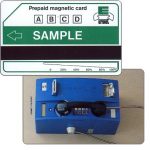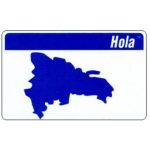In 1985, while SIDA-type phones with yellow blue vertical cards were spreading nationwide, Sip decided to proceed with the experimentation of a new type of additional blue card reader, to be added to existing telephones. This reduces costs because you avoid changing all existing phones. The new light blue readers work with cards in plasticized cardboard with a magnetic strip arranged lengthwise rather than in width (the board becomes “horizontal” instead of “vertical”); the background color becomes white on both sides: it is the so-called “white” series, which will have a semi-experimental character for a period of about two years.
The phones set up for this new type of cards are installed above all in the NATO bases located in Italy: at Maddalena, in Sardinia and at Comiso, just to mention the main ones. The operating instructions are printed in the usual three languages (Italian, English and French), for the “Italian” version and even in four (German is added) for the “Alto Adige” version. The facial values, as well as the progressive numbering, are overprinted on the white base; these values are 3000, 5000, 6000, 10,000 and 20,000 lire for the “Italian” series and 3000, 6000, 10,000 lire for the “Alto Adige” series. The only 20,000 lire card is relatively easy to find in the various markets at a fairly low price as well as that of 10,000 lire in the “Italian” version, which is however at a much higher price. The other cards that make up the basic series, those of 3000, 5000 and 6000 lire, plus 10,000 lire Alto Adige, are instead very difficult to find, both in the new and used state. The “white” series, being, as it were, the same age as the SIDA 2 series, has the same Sip logo with the words “Società Italiana per l’Esercizio telefonico”. When the official name of SIP becomes “Società Italiana per l’Esercizio delle telecomunicazioni Spa” a new type of card is updated with the Sip logo “Società Italiana per l’Esercizio delle Telecomunicazioni S.p.A.”
THE “RED” CARDS COME UP
We are in mid-1986 and the card presents some flashy innovations. First: the color of side A becomes deep red, with the horizontal magnetic band and a gray control band on the lower base, the so-called “leg”. Second: side B with technical explanations in multiple languages remains white; third: the facial values become only two, that is 5,000 and 10,000 lire, and are directly impressed during the first printing phase, without the need for subsequent steps as happened with the white ones. Of the “red” series, there are currently 19 different types, and as such they are collected. The base paper, both in the 5000 lire version and in the 10.000 version, presents on the A side a white rectangular window on the red background for the control numbering (where it is provided). The first issue shows a seven-digit numbering of which the first two are fixed, and are respectively 02 for the cut from 5000 and 04 for the 10,000 lire, followed each by the remaining five more digits.
The total circulation of this first issue, as reported by the catalogs, should be around 80,000 pieces. Since in these cards the zero figure appears both as zero “empty”, and as zero cut from a slash, we can hypothesize that there are as many as four “subtypes” more or less homogeneous of about 15, 20 thousand cards each: the 5000 lire card with empty zero and strikethrough and the 10,000 card with empty zero and strikethrough zero.
During 1987, successive red card issuances were issued, always in conjunction with the SIDA 3, which continue to have the upper hand both for the number and for the diffusion in the territory. The new edition has a six-digit numbering in the usual 5000 and 10,000 lire denominations, and should be 100,000 pieces per type. The availability of the six-digit series, probably due to the very consistent use, is scarce for the used specimens and, even more so for the new ones. The third edition of the “red” series is characterized by a numbering with eight alphanumeric characters (but in the absence of numbers there are only letters, for which there is also the type with eight letters) in the usual denominations of 5000 and 10,000 lire. There is also the version for Alto Adige, in the two variants with eight alphanumeric characters or eight letters: it is rather rare. Then another edition is prepared, analogous in all respects to the previous alphanumeric one, with the only difference being an asterisk added outside the white window. For the run with an asterisk there is no Alto Adige version.
At the beginning of 1988 a new series of the “red” series appeared: the substantial difference compared to the previous cards is that the numbering in the white windows is missing altogether. It is also issued, only in the 5000 lire cut, the version for Alto Adige.
The series ends in the same year with two new issues (5,000 and 10,000 lire facades) which for the first time show the company’s logo (Mantegazza) on the B side.














